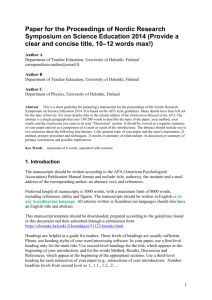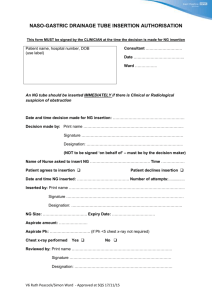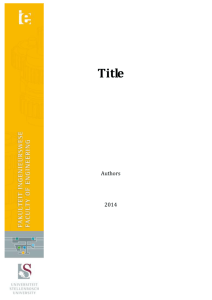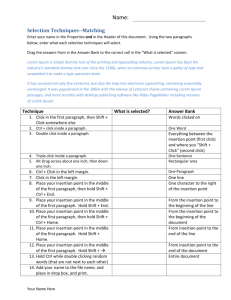Manuscript Template - Wiley Online Library
advertisement
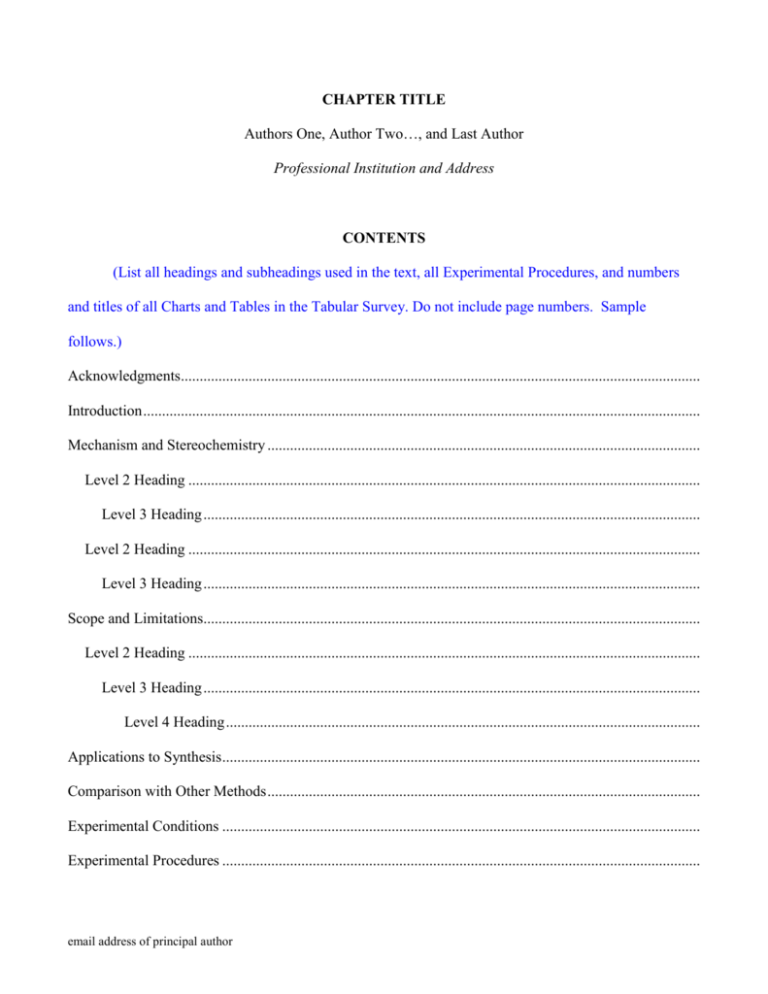
CHAPTER TITLE Authors One, Author Two…, and Last Author Professional Institution and Address CONTENTS (List all headings and subheadings used in the text, all Experimental Procedures, and numbers and titles of all Charts and Tables in the Tabular Survey. Do not include page numbers. Sample follows.) Acknowledgments.......................................................................................................................................... Introduction .................................................................................................................................................... Mechanism and Stereochemistry ................................................................................................................... Level 2 Heading ........................................................................................................................................ Level 3 Heading .................................................................................................................................... Level 2 Heading ........................................................................................................................................ Level 3 Heading .................................................................................................................................... Scope and Limitations.................................................................................................................................... Level 2 Heading ........................................................................................................................................ Level 3 Heading .................................................................................................................................... Level 4 Heading .............................................................................................................................. Applications to Synthesis ............................................................................................................................... Comparison with Other Methods ................................................................................................................... Experimental Conditions ............................................................................................................................... Experimental Procedures ............................................................................................................................... email address of principal author Tabular Survey ............................................................................................................................................... Chart 1. Title ............................................................................................................................................ Chart 2. Title ............................................................................................................................................ Table 1. Title ............................................................................................................................................ Table 2. Title ............................................................................................................................................ Table 3. Title ............................................................................................................................................ References ...................................................................................................................................................... ACKNOWLEDGMENTS (Optional) Begin typing text. INTRODUCTION (The reaction should be defined and illustrated. Historical background, if any, should be brief. Indicate the scope of and limitations to the coverage. Give references to any previous reviews of the reaction.) Begin typing text. Insertion points for relevant graphics (schemes, figures) should follow at the end of the paragraph in which they are first mentioned. Include an insertion number above the graphic. See Appendix II of the Manuscript Guide. (1) [Insert graphic here.] MECHANISM AND STEREOCHEMISTRY 2 (Give a brief discussion of current ideas about the mechanism of the reaction and of any stereochemistry involved. These subjects may be separated into two sections if so desired. Contact the Editorial Coordinator if there are more than 4 levels of sub-headings.) Level 2 Heading Level 3 Heading. Begin typing text. Insertion points for relevant graphics (schemes, figures) should follow at the end of the paragraph in which they are first mentioned. Include an insertion number above the graphic. See Appendix II of the Manuscript Guide. Level 4 Heading. Begin typing text. Insertion points for relevant graphics (schemes, figures) should follow at the end of the paragraph in which they are first mentioned. Include an insertion number above the graphic. See Appendix II of the Manuscript Guide. SCOPE AND LIMITATIONS (Give a critical analysis of the current status of the reaction. All phases of the reaction should be illustrated with equations and product yields. Include currently known limitations on the scope of the reaction; and suggestions for new applications or extensions of the reaction. Level 2 Heading Level 3 Heading. Begin typing text. Insertion points for relevant graphics (schemes, figures) should follow at the end of the paragraph in which they are first mentioned. Include an insertion number above the graphic. See Appendix II of the Manuscript Guide. Level 4 Heading. Begin typing text. Insertion points for relevant graphics (schemes, figures) should follow at the end of the paragraph in which they are first mentioned. Include an insertion number above the graphic. See Appendix II of the Manuscript Guide. 3 APPLICATIONS TO SYNTHESIS (Include a few examples of important syntheses in which the reaction has been used. Format for headings is as given above.) Begin typing text. Insertion points for relevant graphics (schemes, figures) should follow at the end of the paragraph in which they are first mentioned. Include an insertion number above the graphic. See Appendix II of the Manuscript Guide. COMPARISON WITH OTHER METHODS (Summarize advantages and disadvantages of the reaction in comparison with other routes to the same products. Format for headings is as given above.) Begin typing text. Insertion points for relevant graphics (schemes, figures) should follow at the end of the paragraph in which they are first mentioned. Include an insertion number above the graphic. See Appendix II of the Manuscript Guide. EXPERIMENTAL CONDITIONS (Comment on preferred catalysts, solvents, and conditions for using the reaction. Describe any unusual techniques for handling reagents or isolating products. Include comments on significant hazards and safety precautions. If a particularly hazardous reagent, product, or byproduct is involved, provide a laboratory procedure for destroying it.) Begin typing text. Insertion points for relevant graphics (schemes, figures) should follow at the end of the paragraph in which they are first mentioned. Include an insertion number above the graphic. See Appendix II of the Manuscript Guide. 4 EXPERIMENTAL PROCEDURES (Provide examples of the reaction taken from the literature. Include enough procedures to illustrate significant applications and variations of the reaction, being selective so as to minimize redundancy. Select examples that provide the most detailed description of the experiment for that example, including representative yields and thorough characterization of the products. Precede the procedure with a reaction graphic that illustrates it. Follow the name of the product with a short phrase identifying the reaction type.) (67) [Insert reaction graphic here.] Name of Product (Reaction Type). Begin experimental description on this line. Use this form for analytical data. Chemical shift data should follow the same order, either ascending or descending, in all of the procedures. See page 8 of the current Manuscript Guide for correct formatting of the data. …to give the title compound (x mg, y%) as a white solid: mp #°; Rf ; IR; 1H NMR (### MHz, solvent) chemical shifts to two decimal places (s, d, t, or m, J = #, #H); 13C NMR (### MHz, solvent) chemical shifts to one decimal place; HRMS. Anal. Calcd for [formula]: C, ##.##; H, #.##. Found: C, ##.##; H, #.##. TABULAR SURVEY (Write an introduction that describes the organization of the Tabular Survey, the cutoff date for the literature survey, and any unusual conventions used in the Tables. Provide a list of abbreviations used in the Tables (see any recent Organic Reactions chapter for examples). Note that JOC-approved abbreviations (Appendix VII) need not be included.) 5 Begin typing text. The following abbreviations, excluding those found in "The Journal of Organic Chemistry Standard Abbreviations and Acronyms" are used in the text and the Tables. REFERENCES [The references, which should either be in code or as Endnote citations (see Manuscript Guide), are to be provided as a separate document sorted in alphabetical order of the code, or as an EndNote library.] 6

